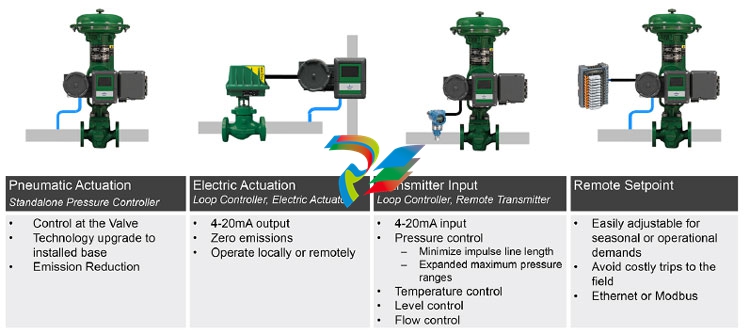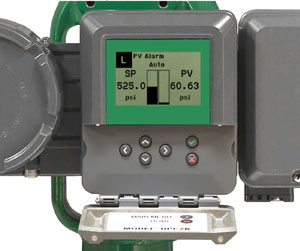
When Pneumatic Standalone Controllers Age Out

Taking advantage of technology
These types of hybrid controller replacements also take advantage of the latest technology to address the inherent limitations of pneumatic controllers. The digital PID loop operates on 50 millisecond cycles, making it suitable for very fast and difficult to control process applications.
The list of advanced control options and parameters includes anti-reset windup, dynamic reset limiting and configurable deadband, enabling this type of controller to provide far superior tracking to setpoint as compared to its pneumatic predecessor. A local digital interface (Figure 3) displays control data, and it allows easy setpoint and configuration modifications at the device.
In many applications, the most important technological advance will be the remote communication capabilities that are now incorporated within the controller. These types of devices can typically communicate via Modbus TCP, HART IP, and/or Modbus RTU RS-485. The Ethernet port can handle multiple protocols simultaneously using Modbus TCP or HART IP, and all digital protocols provide remote control and monitoring capability.
This communication capability allows the local controller to independently perform its control tasks, while providing a means to remotely change setpoints, gather analog signals from up to two devices, detect alarms and equipment alerts, and reconfigure the device if necessary. With this capability, the pneumatic controller is no longer an isolated island of automation, but it can instead provide process data to indicate developing problems, empowering plant personnel to react proactively to minimize downtime and production loss.
These new controllers have also been designed with ease of use and maintenance in mind. Configuration is simple and straightforward, using intuitive menus at the device, or via a free software application with remote access. Maintenance is greatly reduced due to the lack of moving parts, and when needed it requires little technical knowledge since the pressure sensors and pneumatic output sections are modular and can thus be easily replaced.

Applications for standalone digital process controllers
Standalone digital process controllers are often the preferred solution for a wide variety of single loop control applications. Common use cases include heaters in tank farms, pressure and temperature controllers for heat trace applications, and fuel gas train pressure controllers. These controllers are also frequently used on equipment skids where local control is required.
Another very common application is a back pressure controller for remote wellhead oil separator applications (Figure 4). While oil/water interface and oil level control can be accomplished by other means, backpressure control on the separator usually demands tighter tracking to setpoint, as can be provided with a PID controller.
These new replacement process controllers are tailor made for this application and are often employed during wellhead electrification projects to limit or eliminate methane emissions. The controllers can also be used in advanced oil recovery projects that require local flow or pressure controls at remote wellhead sites.
Another common application is tank blanketing applications. These advanced pneumatic controllers provide local and independent pressure control, and they also provide a means to remotely monitor tank pressure, and alarm if the blanketing system is not operating correctly. This type of solution is far superior to a blanketing pressure regulator, which tends to droop at high flows and offers no means of pressure feedback.

Conclusion
If your plant has a number of aging pneumatic controllers—or if you encounter an application where remote, independent control is necessary—consult with your valve automation vendor to investigate new standalone digital process controllers. The control capability of these new solutions is far superior to what has been available to date, and their flexibility allows them to be used in a very wide variety of flow, pressure, temperature, and level control applications.
These pneumatic controller replacements also offer the ability to monitor, control and even configure these devices remotely, and they provide a wealth of process data previously unavailable from these remote, single-loop control applications. These venerable pneumatic controllers have done their duty for decades, but as they age out, a very capable and superior replacement is now available.



.jpg)
















































.jpg)
.jpg)





.jpg)



.png)
.jpg)

.jpg)
_lVjBYb.jpg)

.jpg)
.jpg)



.jpg)
.jpg)







.jpg)

.jpg)
.jpg)











.jpg)




.jpg)
.jpg)
.jpg)
.jpg)
.jpg)
.jpg)

.jpg)

.jpg)
.jpg)
.jpg)








